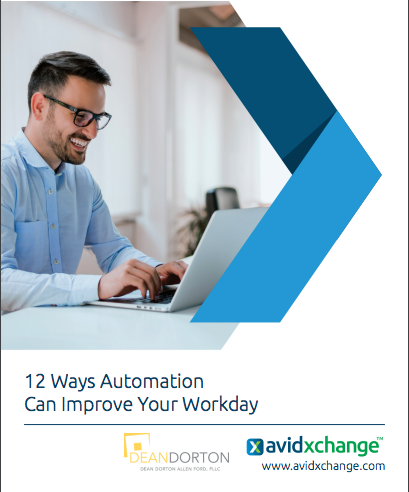This blog was reposted from our partner, AvidXchange.
We all know that the accounts payable process isn’t a straight and narrow path. Several small steps can make a big difference when it comes to paying vendors on time—invoice entry, approvals, and handling different payment methods. These steps aren’t all that simple, especially with paper.
 Paper is the reason for most problems plaguing finance departments. Common obstacles that stem from paper include hours of manual labor, errors, and fraud risks that could cost your business thousands of dollars. The time and money spent solving these problems are one of the many reasons why finance decision-makers are considering a paperless accounts payable process—AP automation solutions.
Paper is the reason for most problems plaguing finance departments. Common obstacles that stem from paper include hours of manual labor, errors, and fraud risks that could cost your business thousands of dollars. The time and money spent solving these problems are one of the many reasons why finance decision-makers are considering a paperless accounts payable process—AP automation solutions.
Currently, there’s a lot of buzz around finance departments transforming from paper to paperless accounts payable processes. They want to reduce the time spent on manual tasks and streamline the process without missing critical steps. Businesses want flexibility, visibility, and security when paying vendors, which just isn’t possible with paper.
If your finance staff is facing any of the typical payment problems, we have four simple solutions to ease the pain:
4 accounts payable problems and reasons to seek a paperless AC process
1) Your paper-based accounts payable process makes it impossible to improve long-term strategies and visibility.
Even though paper-based accounts payable processes and strategies may be working just fine for your finance department, they’re not the best. Storing invoices, receipts, and vendor information in a file cabinet makes it nearly impossible to predict financial problems or opportunities accurately. Chances are if you’re analyzing payment data with piles of paper and Excel files, there’s a high chance of errors and limited visibility into ineffective spend or vendor costs over time. Not to mention the amount of time spent analyzing information, rummaging through file cabinets, and looking for lost printed invoices and vendor records.
With a paperless accounts payable process, finance leaders have easy access to historical payment information and customized reports to make well-informed decisions without paper or manual labor. The AP staff has all information needed for audits, tax season, and month-end closing, all in one cloud-based SaaS. AP automation’s increased level of visibility helps finance leaders stay ahead of potential overspend based on payment history.
2) You’ve established poor vendor relationships thanks to problems with paper.
Let’s face it: vendors dread calling your accounts payable department to checking on invoices or payment statuses. The reality is, that they just want their payments on time. AP specialists waste hours combing through piles of paper to answer these emails and phone calls from vendors.
Paper-based accounts payable processes often lead to late payments. Late payments and lack of communication often lead to poor vendor relationships. From a supplier’s point of view, they’re counting on your business’ payments from their sales to avoid debt and effectively manage their budgets just like your business. With paper-based accounts payable processes, it’s nearly impossible to provide vendors with real-time updates and visibility into your finance department’s accounts payable process.
The best solution to keep the supplier happy is a paperless AP process. AP automation solutions allow companies to log in to the supplier portal to get real-time updates on each invoice and view payment history without phone calls and emails. Many AP automation solutions also have the option to pay vendors in batches when using electronic payments. There’s also less worry about managing different payment types. For example, the AvidPay Network handles the heavy lifting of contacting vendors to verify payment types to save your finance department time and money.
3) You’re stuck in the Stone Age of paying with paper checks.
Why are businesses still clinging to the Stone Age with paper checks? For most finance departments, it’s convenience and cost savings. However, organizations that use paper processes often have to rely on internal processes to double check for fraud, but that’s not enough. Finance departments that stick to paper run the risk of duplicate invoices which can lead to duplicate payments. Or even worse, they may mail a paper check to a scammer who sent a fake invoice.
 4) Your finance department is spending more than expected on payment processing.
4) Your finance department is spending more than expected on payment processing.
Most finance leaders don’t invest in AP automation solutions because they’re afraid that they won’t see a return on the investment. There’s the common misperception that AP automation solutions are for larger businesses that have high payment volume. So, naturally, these companies stick to paper-based accounts payable processes that don’t seem to cost as much money, but in fact, paper processes cost more. On average, companies are paying $22 to process a single paper invoice. According to Due.com, some companies are spending as much as $40. If your company handles at least 500 invoices per month, you may be spending as much as $11,000 to process your payables.
Paper checks also have high costs. According to PYMNTS.com, processing one check can cost your business almost $10. That doesn’t include manual labor costs and hours spent. Multiplying these costs by the number of payments received each month can add up quickly. On the other hand, AP automation solutions cut accounts payable costs by as much as 60 percent for many businesses.
